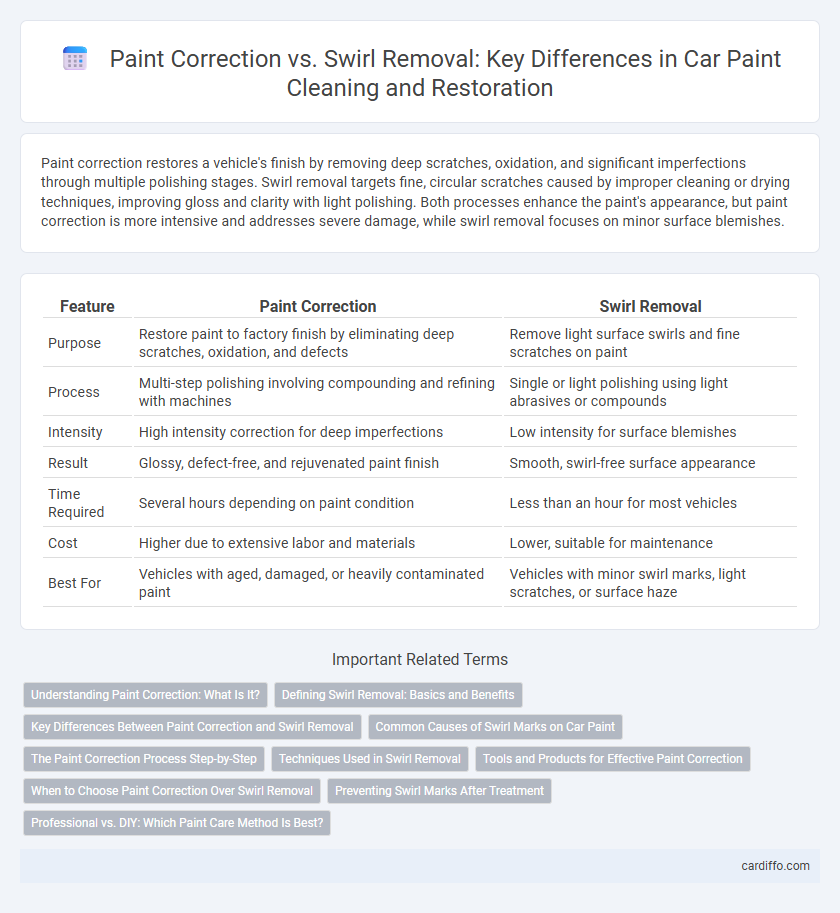Paint correction restores a vehicle's finish by removing deep scratches, oxidation, and significant imperfections through multiple polishing stages. Swirl removal targets fine, circular scratches caused by improper cleaning or drying techniques, improving gloss and clarity with light polishing. Both processes enhance the paint's appearance, but paint correction is more intensive and addresses severe damage, while swirl removal focuses on minor surface blemishes.
Table of Comparison
| Feature | Paint Correction | Swirl Removal |
|---|---|---|
| Purpose | Restore paint to factory finish by eliminating deep scratches, oxidation, and defects | Remove light surface swirls and fine scratches on paint |
| Process | Multi-step polishing involving compounding and refining with machines | Single or light polishing using light abrasives or compounds |
| Intensity | High intensity correction for deep imperfections | Low intensity for surface blemishes |
| Result | Glossy, defect-free, and rejuvenated paint finish | Smooth, swirl-free surface appearance |
| Time Required | Several hours depending on paint condition | Less than an hour for most vehicles |
| Cost | Higher due to extensive labor and materials | Lower, suitable for maintenance |
| Best For | Vehicles with aged, damaged, or heavily contaminated paint | Vehicles with minor swirl marks, light scratches, or surface haze |
Understanding Paint Correction: What Is It?
Paint correction is a detailed process used to restore and enhance the vehicle's paint surface by removing imperfections such as swirl marks, scratches, oxidation, and etching. This technique involves wet sanding, polishing, and buffing to eliminate surface defects, improving the clarity and depth of the paint. Unlike simple swirl removal, paint correction addresses a wider range of paint damage, resulting in a smoother, more reflective finish.
Defining Swirl Removal: Basics and Benefits
Swirl removal targets fine, circular scratches caused by improper washing techniques, restoring a vehicle's clear coat to a smooth and glossy finish. This process eliminates micro-abrasions that dull the paint, enhancing overall shine and depth without aggressive polishing. Effective swirl removal extends paint life by preventing oxidation and maintaining surface integrity.
Key Differences Between Paint Correction and Swirl Removal
Paint correction encompasses a comprehensive process that includes multiple stages such as compounding, polishing, and finishing to restore a vehicle's paintwork to a flawless condition. Swirl removal specifically targets the elimination of fine scratches and holograms caused by improper washing or drying techniques. The key difference lies in paint correction's broader scope aimed at correcting all types of paint imperfections, while swirl removal is a focused technique addressing surface-level swirls and minor defects.
Common Causes of Swirl Marks on Car Paint
Swirl marks on car paint are commonly caused by improper washing techniques, such as using dirty or abrasive sponges and towels, which create micro-scratches on the surface. Automatic car washes with harsh brushes can also lead to these fine scratches, as can wiping down the vehicle without lubrication or using dry clothes. Dust, dirt particles, and improper drying methods contribute to swirl marks by grinding against the paint, making paint correction or swirl removal necessary to restore a flawless finish.
The Paint Correction Process Step-by-Step
The paint correction process begins with a thorough wash and clay bar treatment to remove surface contaminants, ensuring a clean base for polishing. Next, multiple stages of machine polishing using varying abrasiveness levels are applied to eliminate swirl marks, fine scratches, and oxidation, restoring depth and clarity to the paint. Finally, a protective layer of sealant or ceramic coating is applied to preserve the corrected finish and enhance long-term durability.
Techniques Used in Swirl Removal
Swirl removal techniques primarily involve the use of dual-action polishers combined with fine abrasive compounds designed to safely eliminate micro-scratches and holograms on automotive paint surfaces. These methods often employ foam pads or microfiber applicators to ensure even pressure distribution, minimizing the risk of further damage while restoring high-gloss finishes. Precision in technique and the correct selection of polishing products are critical for achieving optimal results without compromising the paint's integrity.
Tools and Products for Effective Paint Correction
Professional paint correction relies heavily on advanced polishing machines like dual-action or rotary buffers paired with high-quality cutting compounds and finishing polishes to restore a vehicle's paint clarity. Microfiber towels and foam applicators are essential tools for applying products evenly, while clay bars help eliminate surface contaminants before correction. Selecting reputable brands such as Meguiar's, Menzerna, or 3M ensures effective swirl removal and long-lasting results in paint restoration processes.
When to Choose Paint Correction Over Swirl Removal
Choose paint correction over swirl removal when your vehicle has deep scratches, oxidation, or significant paint defects that swirl removal alone cannot fix. Paint correction involves a multi-stage polishing process that restores the paint's clarity and depth, effectively removing imperfections beyond surface-level swirls. Swirl removal is best suited for minor surface blemishes, while paint correction addresses extensive paint damage for a more thorough and lasting finish.
Preventing Swirl Marks After Treatment
Paint correction restores a vehicle's finish by removing deeper imperfections, while swirl removal targets fine scratches and light surface defects. To prevent swirl marks after treatment, always use microfiber towels specifically designed for automotive surfaces and apply finishing wax or sealant to protect the paint. Regularly washing with pH-balanced, non-abrasive car shampoo minimizes the risk of new swirl marks by reducing friction and abrasive particles.
Professional vs. DIY: Which Paint Care Method Is Best?
Professional paint correction offers precise swirl removal and deep surface leveling using advanced tools and compounds, ensuring a flawless finish that DIY methods often cannot achieve. DIY swirl removal typically involves less aggressive techniques and consumer-grade products, suitable for minor imperfections but limited in correcting severe paint defects. Choosing between professional and DIY paint care depends on the condition of the paint, desired results, and budget, with professionals delivering superior long-term protection and aesthetic enhancement.
Paint Correction vs Swirl Removal Infographic

 cardiffo.com
cardiffo.com